check engine TOYOTA PRIUS PRIME 2017 2.G Owners Manual
[x] Cancel search | Manufacturer: TOYOTA, Model Year: 2017, Model line: PRIUS PRIME, Model: TOYOTA PRIUS PRIME 2017 2.GPages: 784, PDF Size: 14.98 MB
Page 5 of 784
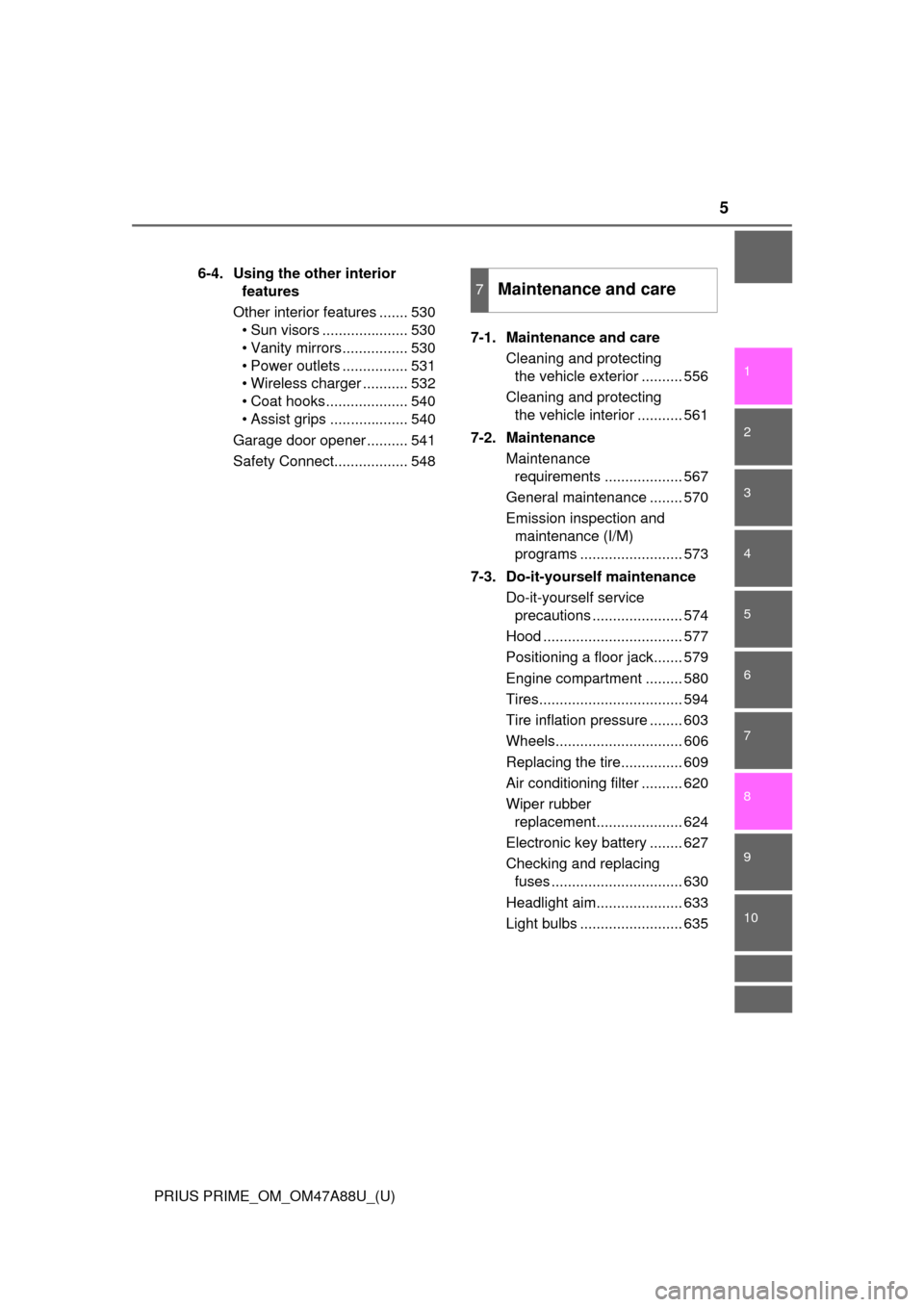
5
1
9 8
7
6 4 3
2
PRIUS PRIME_OM_OM47A88U_(U)
10
5
6-4. Using the other interior features
Other interior features ....... 530 • Sun visors ..................... 530
• Vanity mirrors................ 530
• Power outlets ................ 531
• Wireless charger ........... 532
• Coat hooks.................... 540
• Assist grips ................... 540
Garage door opener .......... 541
Safety Connect.................. 548 7-1. Maintenance and care
Cleaning and protecting the vehicle exterior .......... 556
Cleaning and protecting the vehicle interior ........... 561
7-2. Maintenance Maintenance requirements ................... 567
General maintenance ........ 570
Emission inspection and maintenance (I/M)
programs ......................... 573
7-3. Do-it-yourself maintenance Do-it-yourself service precautions ...................... 574
Hood .................................. 577
Positioning a floor jack....... 579
Engine compartment ......... 580
Tires................................... 594
Tire inflation pressure ........ 603
Wheels............................... 606
Replacing the tire............... 609
Air conditioning filter .......... 620
Wiper rubber replacement..................... 624
Electronic key battery ........ 627
Checking and replacing fuses ................................ 630
Headlight aim..................... 633
Light bulbs ......................... 635
7Maintenance and care
Page 17 of 784
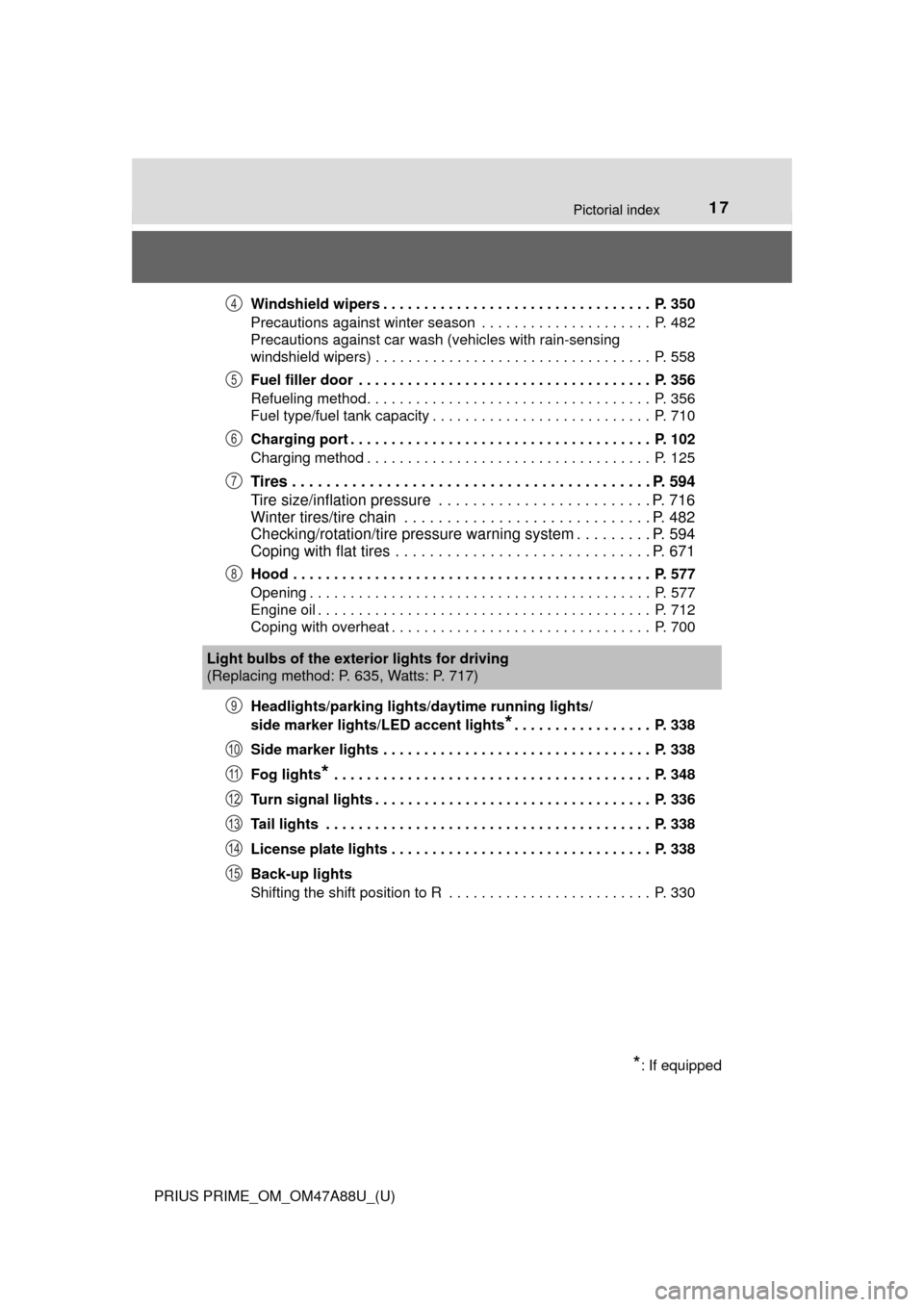
17Pictorial index
PRIUS PRIME_OM_OM47A88U_(U)Windshield wipers . . . . . . . . . . . . . . . . . . . . . . . . . . . . . . . . . P. 350
Precautions against winter season . . . . . . . . . . . . . . . . . . . . . P. 482
Precautions against car wash (vehicles with rain-sensing
windshield wipers) . . . . . . . . . . . . . . . . . . . . . . . . . . . . . . . . . . P. 558
Fuel filler door . . . . . . . . . . . . . . . . . . . . . . . . . . . . . . . . . . . . P. 356
Refueling method . . . . . . . . . . . . . . . . . . . . . . . . . . . . . . . . . . . P. 356
Fuel type/fuel tank capacity . . . . . . . . . . . . . . . . . . . . . . . . . . . P. 710
Charging port . . . . . . . . . . . . . . . . . . . . . . . . . . . . . . . . . . . . . P. 102
Charging method . . . . . . . . . . . . . . . . . . . . . . . . . . . . . . . . . . . P. 125
Tires . . . . . . . . . . . . . . . . . . . . . . . . . . . . . . . . . . . . . . . . . . P. 594
Tire size/inflation pressure . . . . . . . . . . . . . . . . . . . . . . . . . P. 716
Winter tires/tire chain . . . . . . . . . . . . . . . . . . . . . . . . . . . . . P. 482
Checking/rotation/tire pressure warning system . . . . . . . . . P. 594
Coping with flat tires . . . . . . . . . . . . . . . . . . . . . . . . . . . . . . P. 671
Hood . . . . . . . . . . . . . . . . . . . . . . . . . . . . . . . . . . . . . . . . . . . . P. 577
Opening . . . . . . . . . . . . . . . . . . . . . . . . . . . . . . . . . . . . . . . . . . P. 577
Engine oil . . . . . . . . . . . . . . . . . . . . . . . . . . . . . . . . . . . . . . . . . P. 712
Coping with overheat . . . . . . . . . . . . . . . . . . . . . . . . . . . . . . . . P. 700
Headlights/parking lights/
daytime running lights/
side marker lights/LED accent lights
*. . . . . . . . . . . . . . . . . P. 338
Side marker lights . . . . . . . . . . . . . . . . . . . . . . . . . . . . . . . . . P. 338
Fog lights
* . . . . . . . . . . . . . . . . . . . . . . . . . . . . . . . . . . . . . . . P. 348
Turn signal lights . . . . . . . . . . . . . . . . . . . . . . . . . . . . . . . . . . P. 336
Tail lights . . . . . . . . . . . . . . . . . . . . . . . . . . . . . . . . . . . . . . . . P. 338
License plate lights . . . . . . . . . . . . . . . . . . . . . . . . . . . . . . . . P. 338
Back-up lights
Shifting the shift position to R . . . . . . . . . . . . . . . . . . . . . . . . . P. 330
4
5
6
7
8
Light bulbs of the exter ior lights for driving
(Replacing method: P. 635, Watts: P. 717)
*: If equipped
9
10
11
12
13
14
15
Page 79 of 784
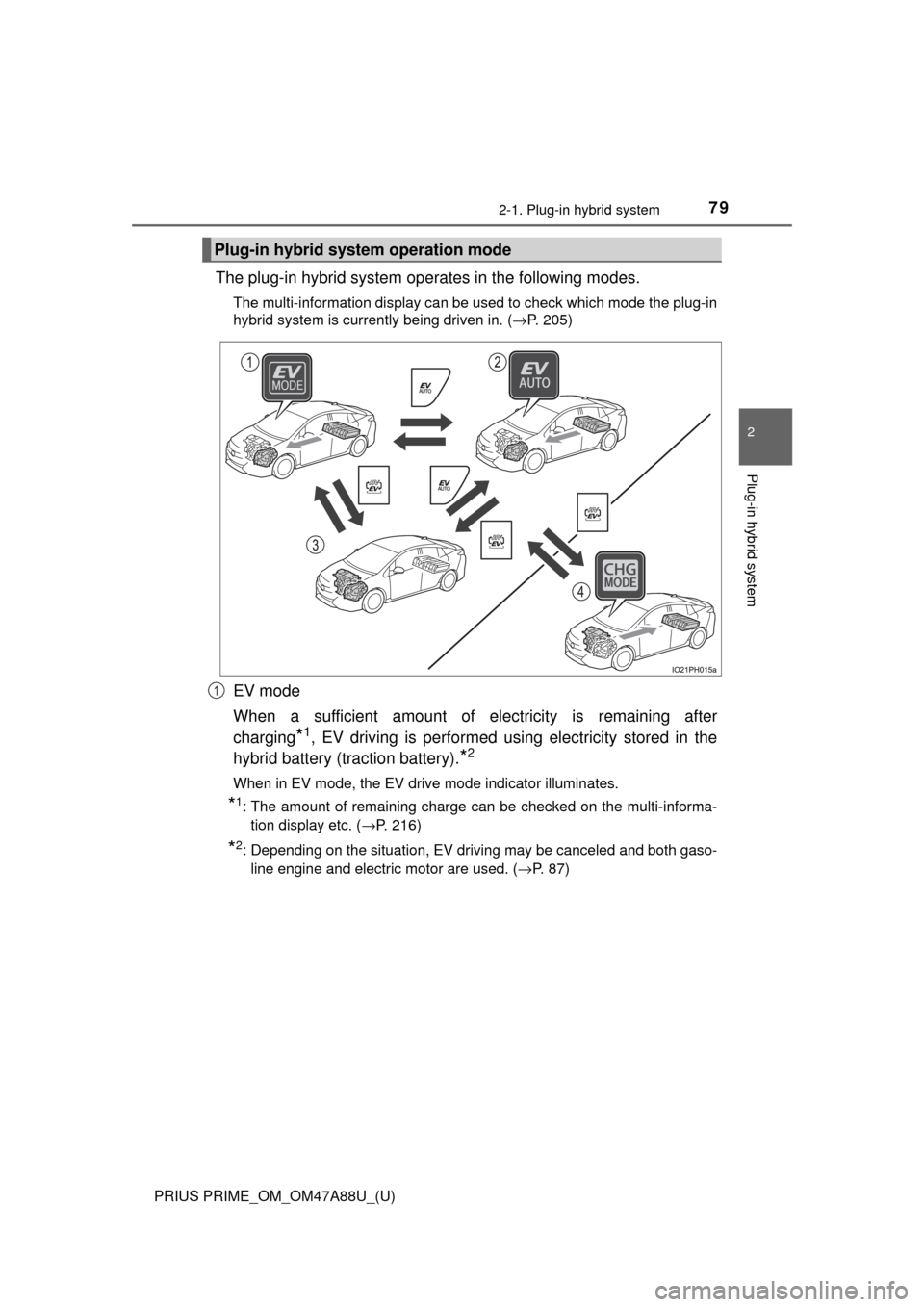
PRIUS PRIME_OM_OM47A88U_(U)
792-1. Plug-in hybrid system
2
Plug-in hybrid system
The plug-in hybrid system operates in the following modes.
The multi-information display can be used to check which mode the plug-in
hybrid system is currently being driven in. (→P. 205)
EV mode
When a sufficient amount of electricity is remaining after
charging
*1, EV driving is performed using electricity stored in the
hybrid battery (traction battery).
*2
When in EV mode, the EV drive mode indicator illuminates.
*1: The amount of remaining charge can be checked on the multi-informa- tion display etc. ( →P. 216)
*2: Depending on the situation, EV driving may be canceled and both gaso-
line engine and electric motor are used. ( →P. 87)
Plug-in hybrid s ystem operation mode
1
Page 80 of 784

80
PRIUS PRIME_OM_OM47A88U_(U)
2-1. Plug-in hybrid system
EV auto mode (→P. 8 2 )
When a sufficient amount of electric ity for EV driving is remaining in
the hybrid battery (tracti on battery) after charging
*, the operation
mode can be switched to EV auto mode.
Switching to EV auto mode make powe rful driving possible by using
both the gasoline engine and electr ic motor in a driving condition
that requires large driving force, such as when passing a vehicle on
a highway or driving on a steep slope.
When in EV auto mode, the EV auto mode indicator illuminates.
*: The amount of remaining charge can be checked on the multi-informa- tion display etc. ( →P. 216)
HV mode
When in HV mode, the vehicle is driven using both the gasoline
engine and electric motor. ( →P. 84)
● If electricity needed for EV driving in EV mode or EV auto mode
is not remaining, the operation mode will be automatically
switched to HV mode.
● The operation mode can be switched to HV mode at any timing
by operating the switch to keep electricity for EV driving etc.
*
(→ P. 82). Switching to HV mode when driving on a highway or
when driving uphill is recommended in order to conserve battery
power.
When in HV mode, the EV drive mode indicator and EV auto mode indi-
cator turn off.
*: The EV driving range may reduce even after switching to HV mode.
2
3
Page 84 of 784
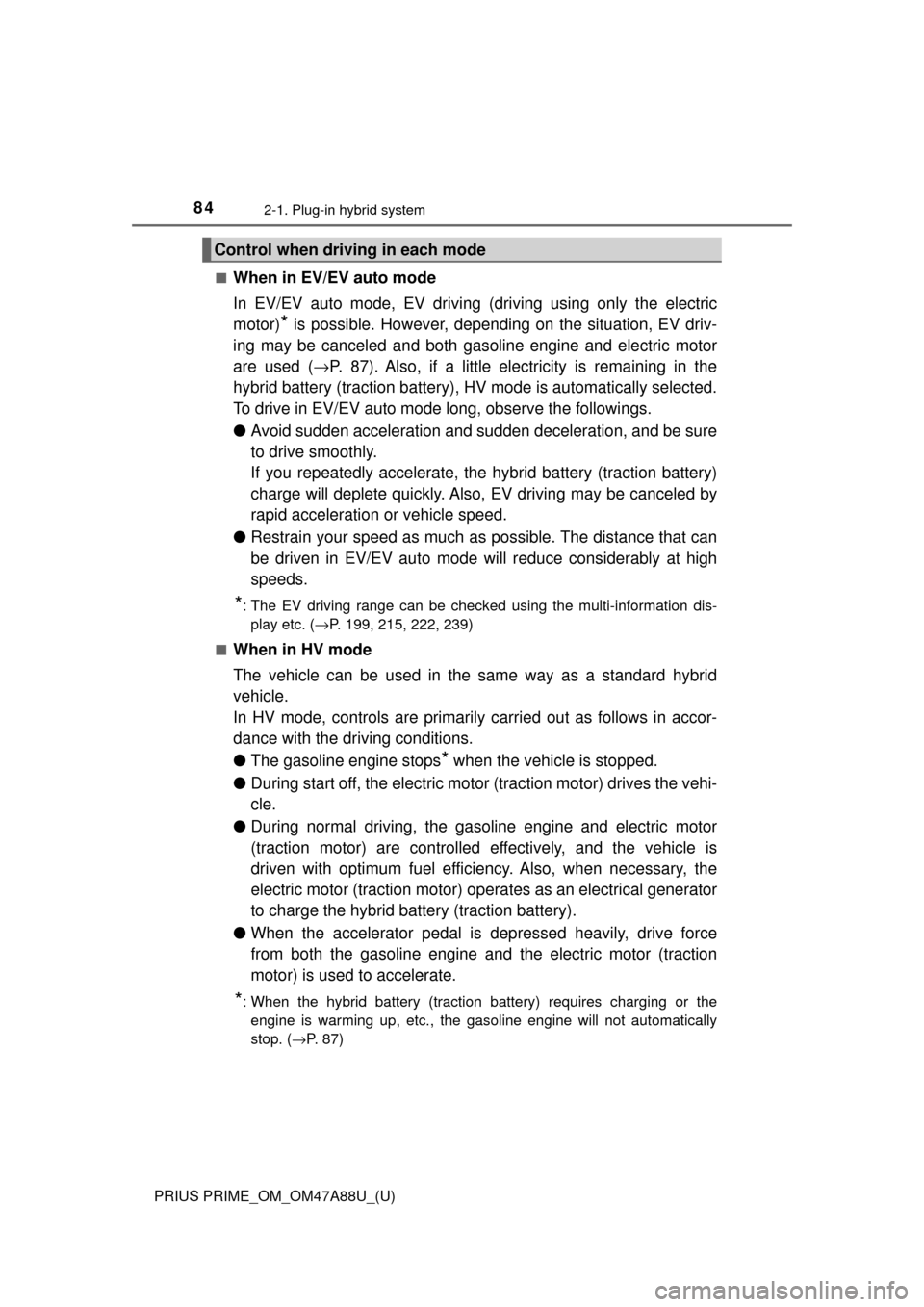
84
PRIUS PRIME_OM_OM47A88U_(U)
2-1. Plug-in hybrid system
■When in EV/EV auto mode
In EV/EV auto mode, EV driving (driving using only the electric
motor)
* is possible. However, depending on the situation, EV driv-
ing may be canceled and both gasoline engine and electric motor
are used ( →P. 87). Also, if a little electricity is remaining in the
hybrid battery (traction battery), HV mode is automatically selected.
To drive in EV/EV auto mode long, observe the followings.
● Avoid sudden acceleration and sudden deceleration, and be sure
to drive smoothly.
If you repeatedly accelerate, the hybrid battery (traction battery)
charge will deplete quickly. Also , EV driving may be canceled by
rapid acceleration or vehicle speed.
● Restrain your speed as much as possible. The distance that can
be driven in EV/EV auto mode wi ll reduce considerably at high
speeds.
*: The EV driving range can be checked using the multi-information dis- play etc. ( →P. 199, 215, 222, 239)
■
When in HV mode
The vehicle can be used in the same way as a standard hybrid
vehicle.
In HV mode, controls are primaril y carried out as follows in accor-
dance with the dr iving conditions.
● The gasoline engine stops
* when the vehicle is stopped.
● During start off, the electric motor (traction motor) drives the vehi-
cle.
● During normal driving, the gasoline engine and electric motor
(traction motor) are controlled effectively, and the vehicle is
driven with optimum fuel efficiency. Also, when necessary, the
electric motor (traction motor) op erates as an electrical generator
to charge the hybrid battery (traction battery).
● When the accelerator pedal is dep ressed heavily, drive force
from both the gasoline engine and the electric motor (traction
motor) is used to accelerate.
*: When the hybrid battery (traction battery) requires charging or the engine is warming up, etc., the gasoline engine will not automatically
stop. ( →P. 87)
Control when driving in each mode
Page 86 of 784

86
PRIUS PRIME_OM_OM47A88U_(U)
2-1. Plug-in hybrid system
■Regenerative braking
In the following situations, kinetic energy is converted to electric energy and
deceleration force can be obtained in conjunction with the recharging of the
hybrid battery (traction battery).
●The accelerator pedal is released while driving with the shift position in D or
B.
● The brake pedal is depressed while driving with the shift position in D or \
B.
■ EV driving range
●The EV driving range is displayed on the multi-information display etc.
(→P. 199, 215, 222, 239)
● The EV driving range changes in accordance with the charge status of the
hybrid battery (traction battery), the speed of the vehicle, etc.
● Even if there is enough charge remaining in the hybrid battery (traction bat-
tery), EV driving may be canceled and both gasoline engine and electric
motor are used depending on the situation. ( →P. 87)
■ After EV mode has switched to HV mo de due to low hybrid battery (trac-
tion battery) charge
If the hybrid battery (traction battery) is regenerated by driving continuously
down a long slope, the EV driving range etc. will be displayed on the multi-
information display and EV mode will be automatically switched to.
If EV mode is not switched to even though EV driving range is being dis-
played, EV mode can be switched to by pressing the EV/HV mode selection
switch.
■ Refilling fuel
Plug-in hybrid vehicles can be driven using electricity charged from an exter-
nal power source. However, as the gasoline engine is used depending on the
situation even if in EV mode, and the gasoline engine is provided on board as
a power source for driving in HV mode, it is needed to refueling the vehicle.
Check the fuel amount and refill immediately when the fuel level becomes
low. ( →P. 356)
Page 88 of 784

88
PRIUS PRIME_OM_OM47A88U_(U)
2-1. Plug-in hybrid system
■If the vehicle is not used for a long time
●The 12-volt battery may discharge. In this event, charge the 12-volt battery.
(→P. 587)
In order to prevent the hybrid battery (traction battery) from becoming
extremely low in charge, charge the hybrid battery (traction battery) from
external power source or start the hybrid system at least once every 2 or 3
months, and turn the power switch off after the gasoline engine has
stopped automatically. (If the gasoline engine does not start up even after
approximately 10 seconds have passed since the “READY” indicator came
on, the power switch can be turned to off without any further action.)
● When the vehicle is left with the charging cable connected, the electricity
consumption amount of the 12-volt battery increases due to controls, suc\
h
as the system checking, operating. When the charging cable is not needed,
immediately remove it from the vehicle.
■ Sounds and vibrations specific to a hybrid vehicle
There may be no engine sound or vibration even though the vehicle is able to
move with the “READY” indicator is illuminated. For safety, apply the parking
brake and make sure to shift the shift position to P when parked.
The following sounds or vibrations may occur when the hybrid system is
operating and are not a malfunction.
●Motor sounds may be heard from the engine compartment.
● Sounds may be heard from the hybrid battery (traction battery) when the
hybrid system starts or stops.
● Relay operating sounds such as a snap or soft clank will be emitted from the
hybrid battery (traction battery), behind the rear seats, when the hybrid sys-
tem is started or stopped.
● Sounds from the hybrid system may be heard when the back door is open.
● Sounds may be heard from the transmission when the gasoline engine
starts or stops, when driving at low speeds, or during idling.
● Engine sounds may be heard when accelerating sharply.
● Sounds may be heard due to regenerative braking when the brake pedal is
depressed or as the accelerator pedal is released.
● Vibration may be felt when the gasoline engine starts or stops.
● Cooling fan sounds may be heard from the air intake vent. ( →P. 91)
■ Vehicle proximity notification system
In the following cases, the vehicle proximity notification system may be diffi-
cult for surrounding people to hear.
●In very noisy areas
● In the wind or the rain
Also, as the vehicle proximity notification system is installed on the front of
the vehicle, it may be more difficult to hear from the rear of the vehicle com-
pared to the front.
Page 98 of 784

98
PRIUS PRIME_OM_OM47A88U_(U)
2-1. Plug-in hybrid system
◆Accelerator pedal/brake pedal operation
●Drive your vehicle smoothly. Avoid abrupt acceleration and
deceleration. Gradual accelerati on and deceleration will make
more effective use of the electric motor (traction motor) without
having to use gasoline engine power.
● Avoid repeated acceleration. Repeated acceleration consumes
hybrid battery (traction battery) power, resulting in poor fuel con-
sumption. Battery power can be restored by driving with the
accelerator pedal slightly released.
◆When braking
Make sure to operate the brakes gently and a timely manner. A
greater amount of electrical energy can be regenerated when slow-
ing down.
◆Delays
Repeated acceleration and deceleration, as well as long waits at
traffic lights, will lead to high fuel and electricity consumption.
Check traffic reports before leav ing and avoid delays as much as
possible. When driving in a traffi c jam, gently release the brake
pedal to allow the vehicle to move forward slightly while avoiding
overuse of the accelerator pedal. Doing so can help control exces-
sive electricity and fuel consumption.
◆Highway driving
● Control and maintain the vehicl e at a constant speed. Before
stopping at a toll booth or similar, allow plenty of time to release
the accelerator and gently apply the brakes. A greater amount of
electrical energy can be regenerated when slowing down.
● Electricity consumption will increa se significantly when driving at
high speeds in EV mode. If there will be a long distance to the
next external charging point after leaving a freeway, it is recom-
mended to drive in HV mode while on the freeway and change to
EV mode after leaving the freeway.
Page 99 of 784
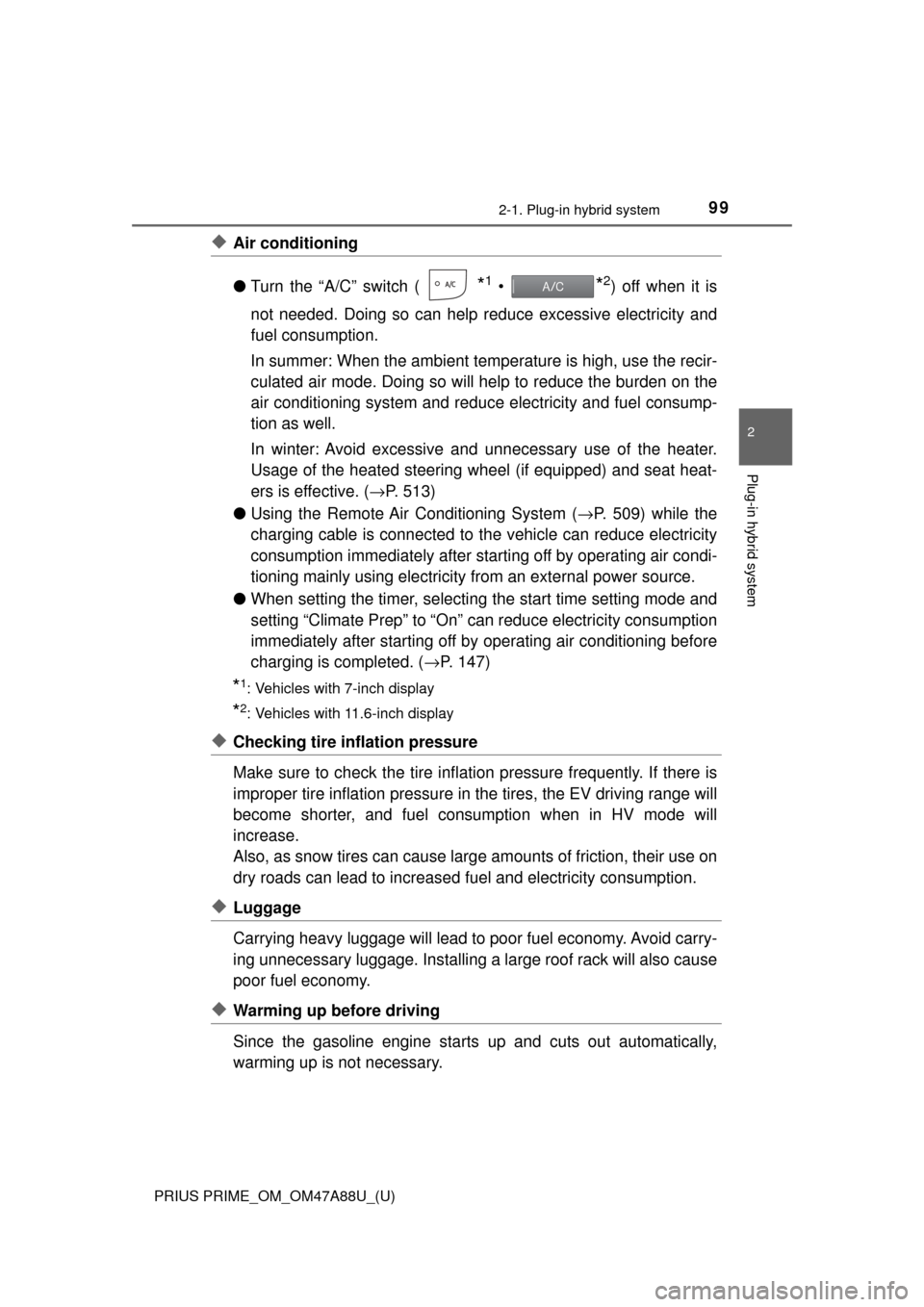
PRIUS PRIME_OM_OM47A88U_(U)
992-1. Plug-in hybrid system
2
Plug-in hybrid system
◆Air conditioning
●Turn the “A/C” switch (
*1 • *2) off when it is
not needed. Doing so can help r educe excessive electricity and
fuel consumption.
In summer: When the ambient temperature is high, use the recir-
culated air mode. Doing so will he lp to reduce the burden on the
air conditioning system and reduc e electricity and fuel consump-
tion as well.
In winter: Avoid excessive and unn ecessary use of the heater.
Usage of the heated steering wheel (if equipped) and seat heat-
ers is effective. ( →P. 513)
● Using the Remote Air Conditioning System (→P. 509) while the
charging cable is connected to th e vehicle can reduce electricity
consumption immediately after starting off by operating air condi-
tioning mainly using electricity from an external power source.
● When setting the timer, selecting the start time setting mode and
setting “Climate Prep” to “On” can reduce electricity consumption
immediately after starting off by operating air conditioning before
charging is completed. ( →P. 147)
*1: Vehicles with 7-inch display
*2: Vehicles with 11.6-inch display
◆Checking tire inflation pressure
Make sure to check the tire infl ation pressure frequently. If there is
improper tire inflation pressure in the tires, the EV driving range will
become shorter, and fuel c onsumption when in HV mode will
increase.
Also, as snow tires can cause larg e amounts of friction, their use on
dry roads can lead to increased fuel and electricity consumption.
◆Luggage
Carrying heavy luggage will lead to poor fuel economy. Avoid carry-
ing unnecessary luggage. Installing a large roof rack will also cause
poor fuel economy.
◆Warming up before driving
Since the gasoline engine starts up and cuts out automatically,
warming up is not necessary.
Page 195 of 784
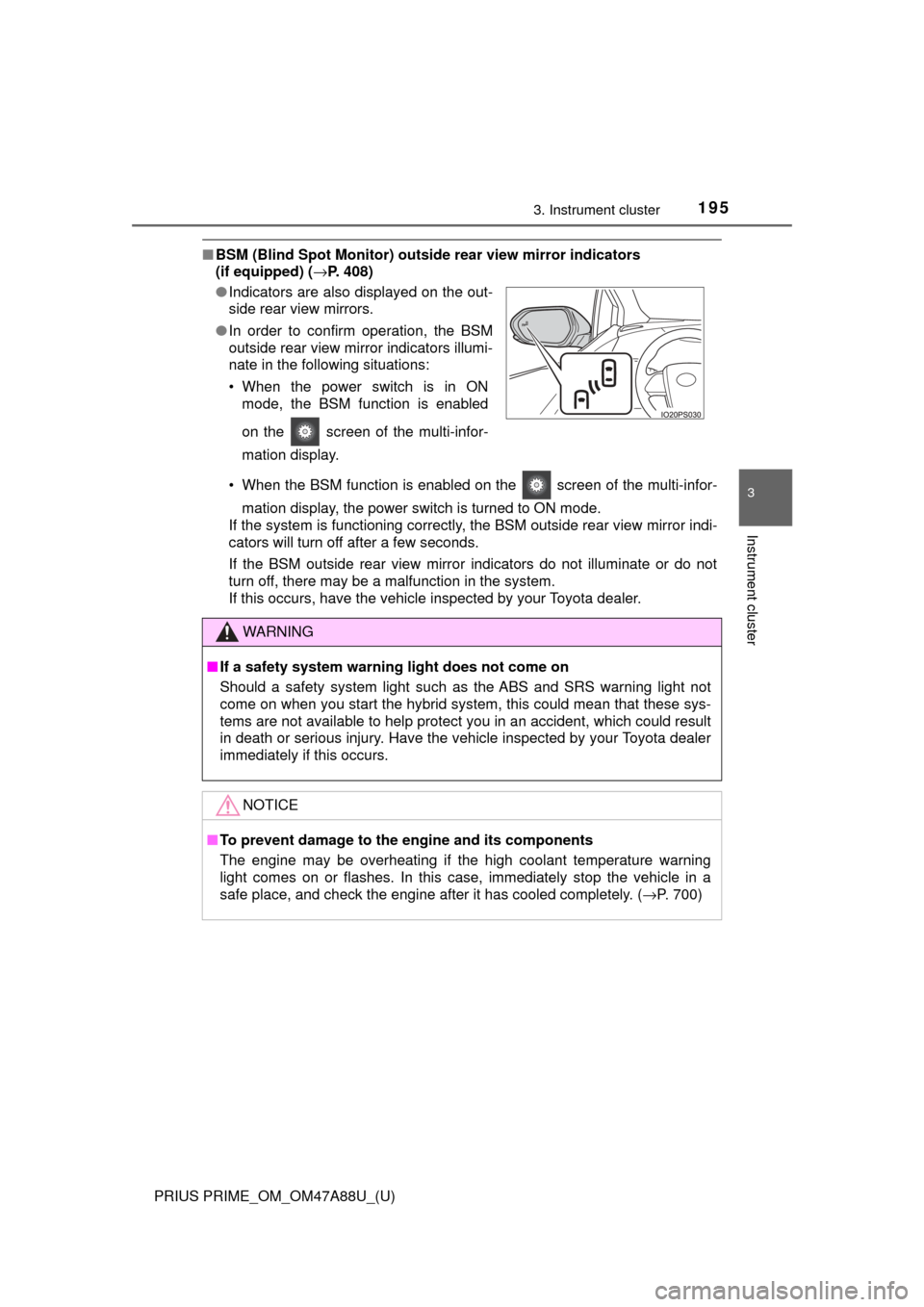
PRIUS PRIME_OM_OM47A88U_(U)
1953. Instrument cluster
3
Instrument cluster
■BSM (Blind Spot Monitor) outsid e rear view mirror indicators
(if equipped) ( →P. 408)
• When the BSM function is enabled on the screen of the multi-infor- mation display, the power switch is turned to ON mode.
If the system is functioning correctly, the BSM outside rear view mirror indi-
cators will turn off after a few seconds.
If the BSM outside rear view mirror indicators do not illuminate or do not
turn off, there may be a malfunction in the system.
If this occurs, have the vehicle inspected by your Toyota dealer.
●
Indicators are also displayed on the out-
side rear view mirrors.
● In order to confirm operation, the BSM
outside rear view mirror indicators illumi-
nate in the following situations:
• When the power switch is in ON
mode, the BSM function is enabled
on the screen of the multi-infor-
mation display.
WARNING
■If a safety system warning light does not come on
Should a safety system light such as the ABS and SRS warning light not
come on when you start the hybrid system, this could mean that these sys-
tems are not available to help protect you in an accident, which could r\
esult
in death or serious injury. Have the vehicle inspected by your Toyota dealer
immediately if this occurs.
NOTICE
■To prevent damage to the engine and its components
The engine may be overheating if the high coolant temperature warning
light comes on or flashes. In this case, immediately stop the vehicle in a
safe place, and check the engine after it has cooled completely. ( →P. 700)